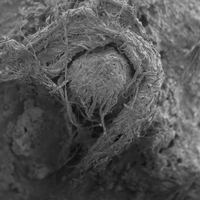neanderthal

How Genes from Neanderthals Predispose People to Severe COVID-19
Alakananda Dasgupta | Feb 22, 2023 | 4 min read
Researchers dissect the Neanderthal-derived region on chromosome 3 that drives severe COVID-19 to zero in on the key causal variants.

Svante Pääbo Awarded Nobel for Paleogenomics
Shawna Williams | Oct 3, 2022 | 3 min read
The geneticist’s accomplishments include sequencing Neanderthal DNA and leading the project that identified a new species of hominin, the Denisovans.

Mutation Linked to Difference Between Human and Neanderthal Brains
Dan Robitzski | Sep 9, 2022 | 5 min read
A single amino acid substitution in a protein causes increased neuron production in the frontal lobes of humans compared to Neanderthals—a tiny difference that could have given our species a cognitive edge, researchers say.

Gonorrhea-Blocking Mutation Also Protects Against Alzheimer’s: Study
Holly Barker, PhD | Aug 5, 2022 | 4 min read
Research traces the evolution of a gene variant that reduces the risk of Alzheimer’s disease, finding that it originally evolved in response to infectious bacteria.

Ancient Tooth Could Be Clue in Denisovan Migration Mystery
Andy Carstens | May 18, 2022 | 2 min read
The new fossil from Laos helps answer the question of how some people from Oceania carry DNA from the ancient hominin.

Gene Variant Points to Starvation’s Evolutionary Legacy
Sophie Fessl, PhD | Sep 28, 2021 | 4 min read
Ancient and modern genomes reveal that a variant of the human growth hormone receptor likely helped our ancestors survive when food was scarce.

Uncovering Ancient Residual DNA
The Scientist | Aug 27, 2021 | 1 min read
A look at how ancient events crafted modern human DNA and their potential impact on human health.

Indigenous Filipino Group Has Highest Known Denisovan Ancestry
Annie Melchor | Aug 13, 2021 | 3 min read
Researchers found the relatively high proportion of DNA from a hominin cousin—nearly 5 percent—when they scanned more than 1,000 genomes from 118 distinct ethnic groups.

The Extinct Species Within
Christie Wilcox, PhD | Aug 6, 2021 | 10+ min read
The genomes of living animals are littered with DNA from long-gone relatives, providing a lens on evolution, past extinctions, and perhaps even solutions to agricultural problems.

65,000-Year-Old Cave Markings Made by Neanderthals: Study
Lisa Winter | Aug 3, 2021 | 2 min read
An analysis concludes that pigments were transported into the cave, and the marks were made with intention, though their ultimate meaning remains unknown.

“Dragon Man” May Replace Neanderthal as Our Closest Relative
Amanda Heidt | Jun 25, 2021 | 8 min read
A massive, well-preserved skull discovered in China in the 1930s belongs to a new species called Homo longi, researchers report, but experts remain skeptical about the evidence.

Gene-Edited Organoids Explore Neanderthal Brain Function
Jef Akst | Feb 12, 2021 | 3 min read
Using CRISPR to swap an archaic variant of the NOVA1 gene into human stem cells, researchers create organoids with neurodevelopmental differences from those carrying modern DNA.

The Biggest Science News of 2020
Kerry Grens | Dec 23, 2020 | 6 min read
Neanderthal DNA surprises in modern humans, the first blood test for Alzheimer’s, a discovery of new human salivary glands, and, oh yeah, a pandemic

Y Chromosome from Early Modern Humans Replaced Neanderthal Y
Jef Akst | Sep 24, 2020 | 5 min read
A selective advantage may have led the modern human Y chromosome to sweep through the Neanderthal population after it was introduced via interbreeding more than 100,000 years ago.

Genetics Steps In to Help Tell the Story of Human Origins
Katarina Zimmer | Sep 1, 2020 | 10+ min read
Africa’s sparse fossil record alone cannot reveal our species’ evolutionary history.

45,000-Year-Old Human Remains Found in Bulgarian Cave
Jef Akst | May 12, 2020 | 2 min read
A tooth and six bone fragments are the oldest confirmed Homo sapiens fossils in Europe.

Image of the Day: Ancient Fiber Technology
Amy Schleunes | Apr 13, 2020 | 1 min read
Researchers discover a fragment of cord between 41,000 and 52,000 years old that points to Neanderthals’ complex cognitive abilities.

Neanderthal Skeleton Find Supports Idea of Intentional Burials
Amy Schleunes | Feb 19, 2020 | 2 min read
Microscopic plant remnants found near the bones indicate that the ancient humans practiced burying rituals, but the archaeological field is not in full agreement.

Remnants of Extinct Hominin Species Found in West African Genomes
Shawna Williams | Feb 13, 2020 | 2 min read
A study points to the existence of an ancient human relative that interbred with Homo sapiens.
